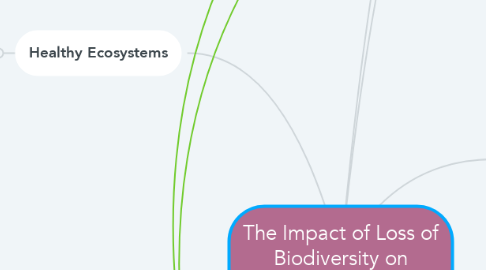The Impact of Loss of Biodiversity on Ecosystem Services
by Danelle Hansen


1. Healthy Ecosystems
1.1. Nature (Wild Areas/Natural Beauty)
1.2. Diversity of Plant and Animal Life, Oceans and Fisheries
1.3. Fertile Soil
1.4. Rain
1.5. Streams
1.6. Lakes
1.7. Groundwater
1.8. Energy resources (Clean Air)
1.9. Weather and Climate
2. Human Well-Being: (Maintaining a healthy environment, and transitioning towards sustainability requires human societies that function well. Social, economic and political breakdown only perpetuate environmental abuses)
2.1. Physical Well-Being
2.1.1. Material Living Standards
2.1.2. Health
2.1.3. Physical Security
2.1.4. Stable Ecosystems
2.2. Emotional and Social Well-Being
2.2.1. Political Voice and Agency
2.2.2. Social Relationships
2.2.3. Work and Leisure
2.2.4. Education
2.2.5. Health
2.2.6. Economic Security
3. Ecosystem Services: (The key components of human well-being are dependent on the biosphere and ecosystems functioning well)
3.1. Supporting Services
3.1.1. Primary Production
3.1.2. Nutrient Cycling
3.1.3. Photosynthesis
3.1.4. Soil Creation
3.2. Provisioning Services
3.2.1. Food
3.2.2. Timber
3.2.3. Fiber
3.2.4. Fuel
3.2.5. Genetic Resources
3.2.6. Pharamaceuticals
3.2.7. Fresh Water
3.3. Regulating Services
3.3.1. Water
3.3.2. Air Quality
3.3.3. Climate
3.3.4. Erosion
3.3.5. Diseasep
3.3.6. Pest
3.3.7. Natural Hazards
3.4. Cultural Services
3.4.1. Aesthetic Values
3.4.2. Spiritual Values
3.4.3. Sense of Place
3.4.4. Cultural Heritage
3.4.5. Knowledge Systems
